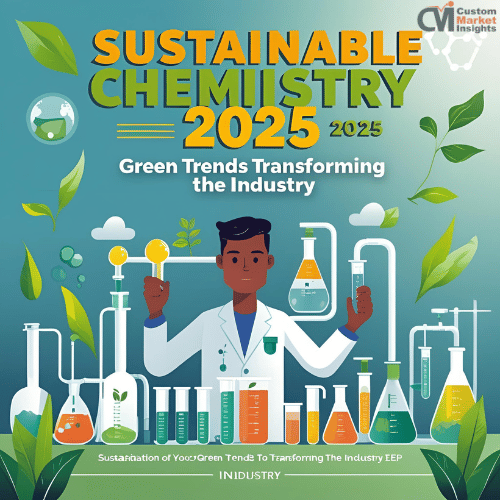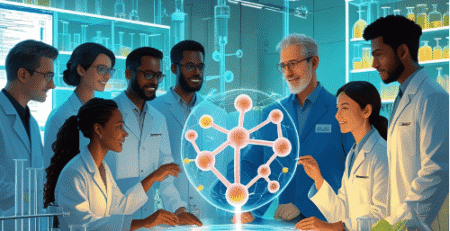Introduction: The Urgent Need for Sustainable Chemistry
As climate change speeds up and rules get stricter around the world, sustainability has become a top priority for businesses in all fields. But the chemical industry has to change the most right now. The industry is responsible for around 6% of global greenhouse gas emissions and relies primarily on fossil-based feedstocks that are running out.
But things are changing. Chemical companies will no longer see sustainability as something they have to do in 2025. Instead, they will see it as a way to promote innovation, efficiency, and a competitive edge. This change signifies a major change in how chemistry is done and scaled, from using renewable feedstocks to closed-loop production processes.
The Rise of Green Chemistry and Renewable Feedstocks
Green chemistry, which uses safer materials and processes that require less energy, is now at the cutting edge of new ideas. Companies are using fewer petroleum-based materials and more bio-based ones, like ethanol from sugarcane, algal oils, and agricultural waste, by 2025.
Green chemistry not only helps the environment, but it also creates new business opportunities. For instance, bio-based polymers are becoming more popular in packaging, building, and cars. Consumer brands are also asking for sustainable supplies, which is making upstream providers reassess what they offer.
Research institutes and businesses are working together to make these new ideas bigger, and more and more pilot plants and industrial-scale facilities are showing that they can be used in business.
Circular Economy: Closing the Loop in Chemical Manufacturing
A circular economy is no longer just a nice idea; it’s becoming a need. The best chemical companies are inventing methods that cut down on waste, get as much material back as possible, and make products last longer.
Chemical recycling, often called advanced recycling, is becoming more popular as an alternative to traditional mechanical recycling in 2025. This method breaks down plastic trash into its original monomers, which means it may be recycled over and over again without losing quality.
Companies are also coming up with “design-for-reuse” techniques, which means that they think about how a product will be used after its useful life from the very beginning of the design process. Sustainable design is helping chemical companies make circular value streams and have less of an impact on the environment, whether it’s with solvents, adhesives, or coatings.
Digital Tools Accelerating Sustainable Practices
Digital transformation is a big part of making chemical manufacturing more sustainable. Blockchain, AI-driven analytics, and real-time monitoring are all being utilized to keep an eye on emissions, make the best use of resources, and make sure that the supply chain is open.
Digital twins, which are virtual copies of real-world assets, let operators test changes to processes before making them in the real world. This not only makes things safer and more efficient, but it also cuts down on energy use and waste by a large amount.
Lifecycle assessment tools also assist businesses in figuring out how much of an impact their products have on the environment, from the raw materials they use to the way they get rid of them. This kind of visibility is essential for keeping up with changing rules and ESG standards.
A Snapshot: Key Areas Driving Sustainable Transformation
The table below summarizes the most impactful focus areas for companies undergoing sustainable transformation in 2025:
| Focus Area | Impact on Sustainability |
| Green chemistry practices | Reduced toxicity, safer production, and cleaner inputs |
| Bio-based feedstocks | Lower carbon emissions and reduced fossil dependency |
| Circular economy models | Waste reduction and improved material recovery |
| Energy efficiency in operations | Lower energy costs and emissions |
| Digital tracking & transparency | Enhanced ESG reporting and regulatory compliance |
| Collaborative innovation | Accelerated scaling of sustainable technologies |
These pillars work together to bring about a complete change that balances environmental aims with business and operational benefits.
Regulations and Incentives Fueling the Shift
Across the globe, governments are increasing the stringency of environmental regulations while simultaneously offering incentives to encourage the adoption of sustainable practices. Chemical manufacturers are being pushed to decarbonize their operations at a faster rate by policies such as the Carbon Border Adjustment Mechanism (CBAM) of the European Union and the Green Hydrogen Mission of India.
At the same time, businesses are finding that it is financially feasible to invest in environmentally friendly technologies thanks to the availability of tax breaks, carbon credits, and public-private research funds at the same time. All of these things have important repercussions for the chemical industry, and the Inflation Reduction Act in the United States is pushing investments in clean hydrogen, carbon capture, and sustainable fuels.
For businesses, being ahead of the regulatory curve is no longer merely a compliance measure; rather, it is now a strategic requirement.
Challenges to Overcome
Even while there is a lot of momentum behind sustainability, there are still many challenges. Making the switch to environmentally friendly feedstocks can be both financially and logistically challenging. Extending the reach of innovative technology frequently necessitates the expenditure of substantial cash and the acquisition of lengthy regulatory permissions.
Moreover, there is a considerable lack of skills in the workforce. In order to accommodate the transition toward digital and environmentally friendly procedures, a new generation of chemists, data scientists, and sustainability specialists is required. It is possible that even the most forward-thinking businesses will have difficulty efficiently implementing change if they do not strategically organize their staff.
The Road Ahead: Collaborate, Innovate, Decarbonize
Although it is not a linear path, the chemical sector must move toward sustainability to remain competitive. The businesses that make early investments, collaborate across ecosystems, and integrate sustainability into their core operations will be the ones that emerge victorious in 2025 and beyond.
This transformation is not simply about lowering emissions or adopting circular models; rather, it is about future-proofing operations, satisfying the expectations of stakeholders, and making a significant contribution to the aims of the global climate change initiative.
Final Thoughts: Sustainability as a Business Strategy
One business that is demonstrating that sustainability and profitability are not incompatible with one another is the chemical sector. Sustainability has developed into a full-fledged business strategy as a result of the increased interest of investors in environmental, social, and governance (ESG) performance, the growing demand of customers for environmentally friendly products, and the pressure from regulators.
Companies that integrate their innovation pipelines, supply chains, and workforce plans with sustainable practices in the year 2025 are not only minimizing risks; they are also unleashing long-term growth and resilience in their organizations.
Connect with our Experts


